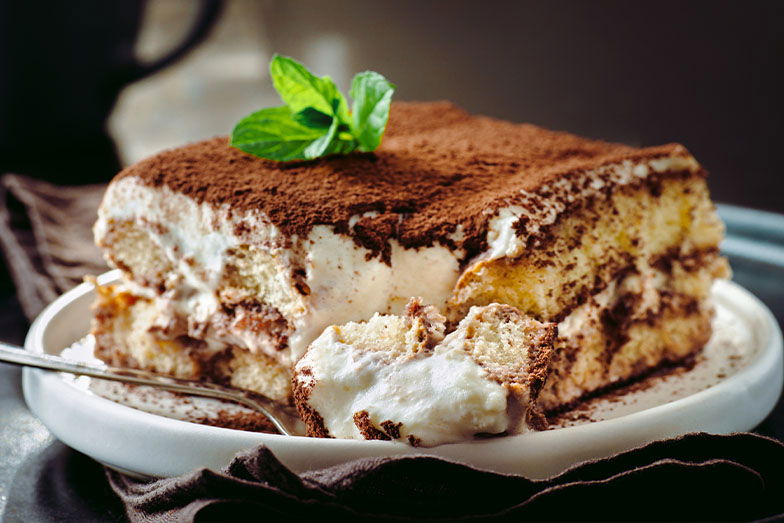Classic elements of Italian cooking…

Originating in the 4th century BC, Italian cuisine evolved under the influence of trade, politics and sociological factors. As noted, it would not be inaccurate to characterize Italian dishes as having “few ingredients and a lot of flavor” But a major determinant in the quality of these dishes is what is in them – Italian cuisine is built on fresh local herbs and produce, artisanal cheeses, breads and pastas, and – of course – high quality olive oils.
However, the region is also an important factor: Seafood, vegetables and olive oils take center stage in the south, while potatoes, corn and cured meats are more prominent in northern dishes.
Delicious Italian cuisine
Italian culinary traditions are incredibly diverse, but we’ve highlighted some of the dishes that are best known around the world.
Pasta dishes and lasagna

With regard to Italian dishes, the first focus is pasta. In Italian cooking, pasta comes in a variety of shapes, lengths and widths. Shorter types are known as “corta”; longer pasta types as “lunga.” Corta-style pasta includes penne, rigatoni and farfalle; lunga-style pasta would include spaghetti, linguine and bucatini. There’s also lasagna; made with wide noodles, this delicious dish features Bolognese-style minced meat and béchamel sauce. flavor.
Traditionally, the ideal consistency for Italian pasta is ‘al dente’ – translated as “to the tooth”-, a toothsome firmness that is enhanced by complex sauces or a simple tossing in olive oil and garlic.
We composed a brief list of pasta types below.
- Spaghetti: Long, medium-thin noodles; usually eaten with tomato sauce.
- Farfalle: Also known as ‘bow tie’ pasta because of its shape.
- Penne: Short, tubular pasta with angled ends; great for absorbing sauces.
- Ravioli: A pasta ‘pocket’, usually filled with ricotta cheese, or a meat or vegetable mixture.
- Fettuccine: Flat, thick noodles that pair nicely with cream and cheese sauces.
- Linguine: A noodle similar to spaghetti but flatter; typically served with seafood.
- Tagliatelle: Long, flat, wide noodles; usually served with meat sauces.
Margherita
Considered by some to be the forerunner of modern pizza, the ‘Margherita’ originated in the southern city of Naples in the 1800s. A flatbread topped with tomatoes, fresh basil and mozzarella cheese, the dish was considered “peasant” fare until Queen Margherita, whose summer residence was in Naples, included it on the menus of the palace kitchen. The dish took her name and, as many have noted, it also bears the colors of the modern Italian flag.
Risotto

Rich and creamy, risotto is made with arborio rice; this Northern Italian dish gets its intense flavor from mushrooms or seafood such as prawns, as well as from butter, parmesan cheese and saffron.
Bruschetta
Bruschetta, an Italian antipasto or appetizer, is a genuine Mediterranean treat. Originally offering a use for day-old bread, toasted bread rounds were topped with a mixture of tomatoes, olive oil and garlic. The variations for bruschetta are nearly endless, with some versions incorporating cooked beans, cheese or cured meats.
Carpaccio

Consisting of paper-thin slices of raw beef, classic carpaccio is considered a delicacy. The slices are dressed in a high quality olive oil, and topped with fresh lemon juice, sea salt, fresh-ground black pepper and shavings of parmesan cheese. The dish can also be made with venison and fish.
Minestrone soup
With its vegetable-heavy recipe, minestrone soup is not only filling but nutritious. In addition to pasta, beans and broth, the soup can contain zucchini, carrots, leeks, celery, tomatoes and even squash or potatoes along with various herbs.
Focaccia

Focaccia, a flatbread with origins in Italy’s northwestern Ligurian region, is made with flour, salt, yeast, honey, olive oil and water, and sometimes topped with dried or cherry tomatoes, rosemary and olives. Savory and delicious, crisp on the outside and soft on the inside, focaccia is also used to make sandwiches.
Gnocchi
Made with potato, flour, eggs and salt, these small dumplings are usually served as a side dish, in a soup, or on their own dressed with a sauce. The dumpling recipe has a number of variations, including the addition of herbs or spices, or substituting sweet potato for the potato.
Tiramisu

And now for desserts: Beloved for its airy texture and delicious taste, classic tiramisu is a pudding-like sweet featuring whipped mascarpone cheese, sugar and eggs, layered over ladyfinger biscuits and topped with cocoa powder.
Panna cotta
Panna cotta is another light, simple and classic Italian dessert. Made with milk, cream, vanilla, sugar and gelatin, the puddling-like dish can be accented with berries, or sauces of coffee, chocolate or caramel.
If your appetite is whetted by this introduction to Italian cuisine, schedule a flight to Italy to further explore this superb gastronomy!

